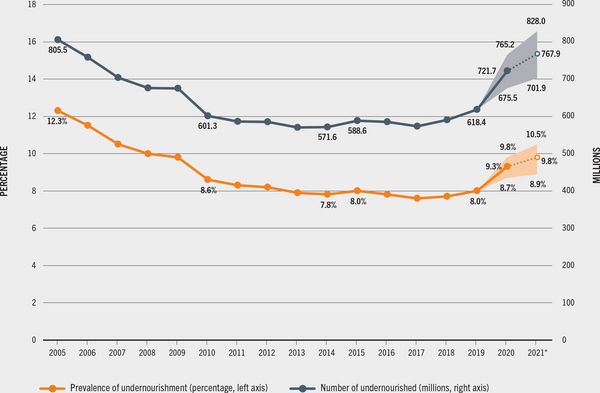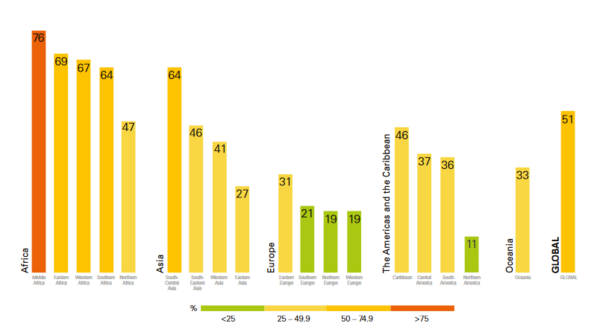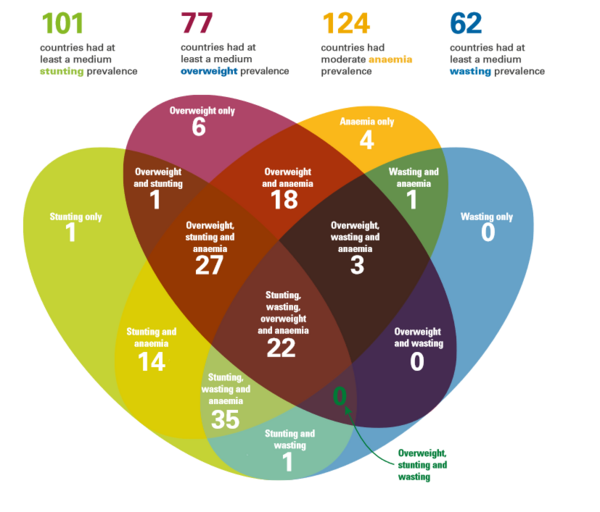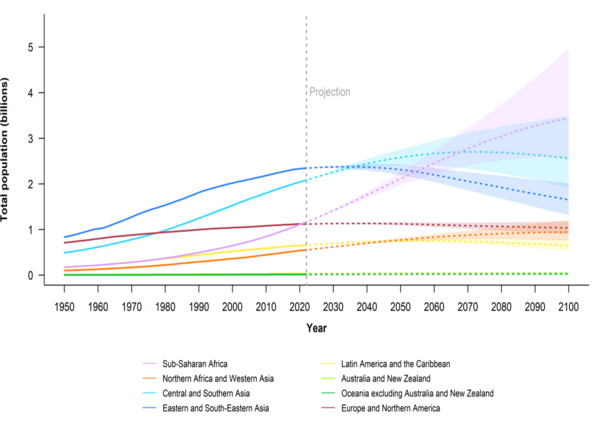Dossier
The state of global food security
Daniela Weible | 10.10.2022
The main goal is clear defined: to end world hunger and undernourishment in all its forms by 2030. The challenges to reach this goal grow with the COVID-19 pandemic, consequences from climatic change as well as due to violence conflicts.
The number of people in the world affected by hunger continued to increase in 2020 under the shadow of the COVID-19 pandemic. Approximately 811 million people in the world face hunger in 2021. In addition to the inadequate supply of macro and micronutrients, the problem of in-creasing overeating characterizes world nutrition.
Agricultural production plays a major role in ensuring that the world's population is fed. Scarce resources as well as environmental, nature, climate and animal welfare aspects make considera-ble progress in the productivity of agriculture, and in some cases also require new technologies. This is especially true for many developing countries.
Not to be forgotten is the trade in agricultural goods and food. It helps to ensure the supply of the population with food by supplementing deficits in local production and generating foreign exchange.
There is still a lot to be done for global food security. To pick out just a few of the many starting points:
- We need more food and a fairer distribution of food.
- All people need to know in which combinations and quantities the existing food contributes to health.
- We need a change in dietary habits in Western countries: this includes a reduction in excessive intake of food energy and the promotion of plant-based diets.
- In the Global South, we especially need better availability of nutrient-rich foods.
- Overall, we need sustainable, healthy and resilient food systems.
- We need both national and international policies that enable healthy nutrition for all.
The number of people in the world affected by hunger has continued to grow in 2020 and 2021 in the shadow of the COVID-19 pandemic. In 2021 approximately 768 million people in the world suffer from hunger. The number of people suffering from chronic hunger worldwide, as measured by prevalence of undernourishment (PoU), has increased by 103 million people in 2020 and further 46 million in 2021. These are the largest annual increases in decades. In addition to inadequate supplies of macro- and micronutrients, the problem of increasing over-nutrition is shaping world nutrition.
These figures are published annually by FAO together with IFAD, UNICEF, WFP and WHO in the report The State of Food Security and Nutrition in the World (SOFI). The FAO defines undernutrition as a lack of energy intake through food because too few calories are consumed. This does not consider inadequate intake of certain macro- and micronutrients.
The minimum number of calories needed for a healthy and productive life varies from person to person. It depends on gender, age, stature and physical activity and ranges from about 1650 to more than 2 000 kilocalories per person per day.
In the 2022 edition of the report, the recent past forecast of global undernutrition rates for 2021 is presented as a range of fire around hunger estimates caused by the unexpected shock of the COVID-19 pandemic.
The situation in Africa is particularly serious
Acute food insecurity in Africa has increased by more than 20 percent from 2019 to 2021 and threatens to worsen as the impact of COVID-19, as well as other events such as conflict and political instability, exacerbate the situation. So far, we have looked at the absolute number of undernourished. But to learn about how malnutrition is faring in a country or region, it helps to look at prevalences (here, the frequency that malnutrition occurs).
Almost 10 percent of the world's population was at risk of hunger in 2021. Africa has the highest prevalence (20.2 percent) compared to other regions. It is followed by Latin America and the Caribbean (8.6 percent) and Asia (9.1 percent). All regions have similar increases (0.4 to 0.6 percentage points) from 2020 to 2021.
Of the total number of undernourished people in 2021, more than half (425 million) live in Asia and more than a third (278 million) in Africa, while Latin America and the Caribbean account for about 7 percent (57 million).
| Prevalence of undernourishment (%) | 2005 | 2010 | 2015 | 2020* | 2021* |
|---|---|---|---|---|---|
| World | 12,3 | 8,6 | 8,0 | 9,3 | 9,8 |
| Africa | 20,7 | 16,5 | 15,8 | 19,6 | 20,2 |
| Northern Africa | 8,4 | 6,4 | 5,2 | 5,9 | 6,9 |
| Sub-Sahara Africa | 23,9 | 18,9 | 18,3 | 22,7 | 23,2 |
| Eastern Africa | 33,8 | 26,5 | 24,4 | 30,2 | 29,8 |
| Middle Africa | 34,9 | 26,0 | 26,3 | 30,4 | 32,8 |
| Western Africa | 12,2 | 9,9 | 10,1 | 13,2 | 13,9 |
| Southern Africa | 4,9 | 5,8 | 7,4 | 9,1 | 9,2 |
| Asia | 13,9 | 9,1 | 8,0 | 8,6 | 9,1 |
| Central Asia | 14,0 | 6,0 | 3,8 | 3,1 | 3,1 |
| Eastern Asia | 6,8 | <2,5 | <2,5 | <2,5 | <2,5 |
| South-Eastern Asia | 17,2 | 10,9 | 7,8 | 5,8 | 6,3 |
| South Asia | 20,5 | 15,3 | 14,1 | 15,9 | 16,3 |
| Western Asia | 7,8 | 5,9 | 9,6 | 10,1 | 10,0 |
| Latin America and the Carribbean | 9,3 | 6,6 | 5,8 | 8,0 | 8,6 |
Remark: Values with *are projections. Source: FAOSTAT 2022.
The table shows that in 2021, undernourishment was more than twice as prevalent in sub-Saharan Africa compared to Asia. Countries in East and Middle Africa were particularly affected, with prevalence rates of 29.8 and 32.8 percent respectively. After initially showing great progress in eliminating hunger, these two regions of Africa have seen a reverse trend since 2018. This trend has been worryingly strong over the last two years.
In Asia, a similar opposite trend can be observed in Southern Asian countries. Here, prevalence increased from 12 percent in 2018 to 16.9 percent in 2021. Central, Eastern and South-Eastern Asia have been able to significantly reduce the proportions of undernourished populations since 2005 and have also remained at comparatively low levels.
In order to be able to adequately assess the situation of world nutrition, it is necessary to look at more than just the supply of calories. For in addition to the obvious undersupply of energy or calories, the lack of micronutrients is just as big a problem worldwide. Even if its effects on health and physical and mental development are less obvious.
First and foremost, vitamins and minerals are micronutrients. Micronutrients are as essential as the macronutrients fat, carbohydrates and protein and are involved in metabolism within cells, such as cell growth, nerve conduction and the formation of secretions and messenger substances.
Worldwide, more than two billion people, especially children, suffer from micronutrient defi-ciencies. The most common are deficiencies of iodine, iron, vitamin A and zinc, with deficiencies of one micronutrient often occurring in combination with deficiencies of other micronutrients.
Sub-Saharan Africa and South Asia particularly affected
Geographically, Sub-Saharan Africa and South Asia are the hotspots of hidden hunger. Pregnant women, children and adolescents are often affected population groups. An estimated 1.1 million of the 3.1 million deaths in children caused by malnutrition each year can be traced back to mi-cronutrient deficiencies.
In contrast to apparent hunger, hidden hunger is also widespread in industrialized countries. In parts of the German population, for example, an insufficient intake of iodine, folic acid, vitamin D or calcium can often be determined. A varied diet with nutrient-rich foods such as fruits, vege-tables, seeds and nuts is important for an adequate supply of micronutrients. Animal products such as eggs, fish, meat and dairy products also contribute.
In many countries of the global south, a balanced and varied diet is often not possible for the population, as foods of this range are not available or households simply cannot afford them despite their availability.
On the other hand, many people have access to a wide range of foods but are not aware of the great importance of a diverse diet and therefore do not take advantage of the food on offer. Malnutrition and insufficient nutrition are often the result of a vicious cycle of a lack of income, poverty, illness and insufficient education.
Many countries experience three malnutrition problems simultaneously: undernutrition, obesity, and micronutrient deficiencies. This triple burden can occur in the same country. In Oceania (excluding Australia and New Zealand), the prevalence of acute malnutrition in 2020 was 9.0 percent while the prevalence of overweight was 8.0 percent. This triple burden occurs even within the same family. An example of this is a family with an overweight mother with anemia and an under-developed child.
Malnutrition is widespread in many countries today, regardless of wealth. The sharp increase in the number of overweight people in Europe or North America is hardly surprising. Rather, it is surprising that this trend is also observed in regions that are severely affected by undernutrition and malnutrition.
Obesity is increasing with particularly steep upward trends among school-age children and adults in all age groups. No region of the world is exempt from this problem. In 2018, 39 percent of adults worldwide were overweight. By comparison, the figure was around 31 percent in 2000.
The transition of diets in countries of the Global South away from traditional diets based on low-processed foods to highly processed, energy-dense, nutrient-poor foods is referred to as the "nutrition transition."
These diets contribute significantly to the spread of non-communicable diseases such as diabe-tes, cancer, and cardiovascular disease. As a result, the role of the nutrition environment in shap-ing changing diets and the various facets of malnutrition is now increasingly a focus of policy attention.
Currently, almost 7.9 billion people live on earth. The world population is currently growing by around 83 million people a year. The Department of Economic and Social Affairs of the United Nations calculates forecasts of population growth and presents a 95% projection interval. The further along the time line of the projection, the less accurate this projection is.
According to this graph, population growth in Africa will increase significantly until 2100, while in Europe, Oceania and the Americas it will stagnate from 2050. In a scenario with medium-fertility projection, the global population in 2050 will be 9.5 billion and in 2100 10.4 billion.











